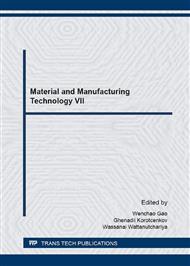p.181
p.187
p.191
p.196
p.201
p.206
p.211
p.216
p.223
Fantastic Carbon Material for Nickel/Carbon Support Catalyst Reducing via Calcination Enhanced with Hydrothermal Carbonization
Abstract:
In generally, the metal catalyst which synthesis by conventional techniques is usually in metal oxide form or easily oxidize in the air thus the metal catalyst must reduce to metallic form before using. It was complex process and dangerous. In the research, Carbon material from cattail flower (CF) were used as supporter of Nickel/Carbon supported metal catalyst (Ni/C). This research were studied effect of used carbon material from CF as supporter of Ni/C and varying nickel loading. The Ni/C catalyst were prepared by hydrothermal, impregnation and calcination process. Firstly, Dried CF has been pretreat via hydrothermal process with optimized condition at 180°C for 8h. Then, the nickel solution was added to support via impregnation method by varying Ni loading from 20 to 60 wt% of supported. Finally, the sample has been pelleted into 0.5mm-Ni/C pellet and calcined at 900°C for 2h under nitrogen atmosphere. Ni/C were characterized by x-ray diffraction (XRD), scanning electron microscopy (SEM), Energy dispersive X-ray (EDX), surface area and pore size distribution was determined by N2 adsorption. The result indicate that nickel particle on Ni/C were in the free metal from without reduction and well dispersed on supported surface. Particle size and surface area of Ni/C were decreases at the increase metal loading. Nickel/Carbon supported metal catalyst were ready to use and could be controlled particle size, surface area and crystallinity by metal loading.
Info:
Periodical:
Pages:
201-205
Citation:
Online since:
September 2016
Keywords:
Price:
Сopyright:
© 2016 Trans Tech Publications Ltd. All Rights Reserved
Share:
Citation:


